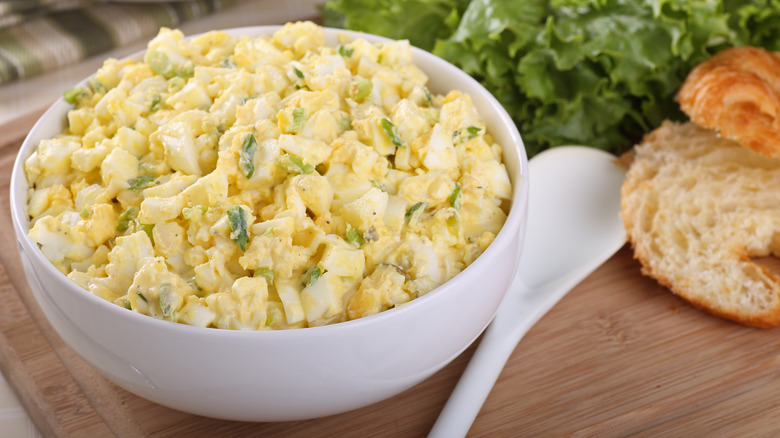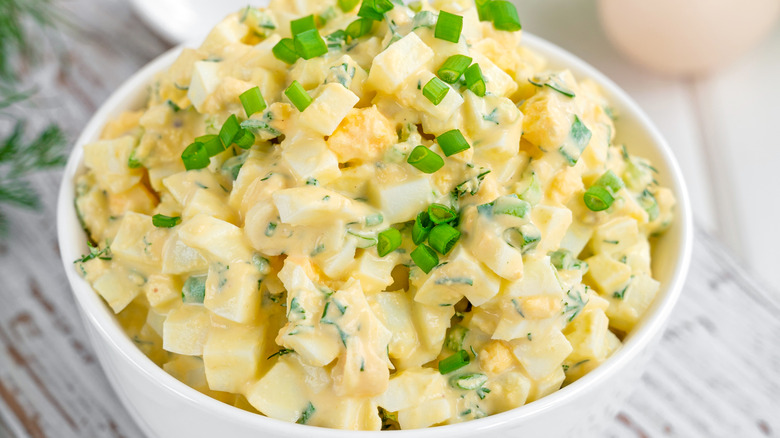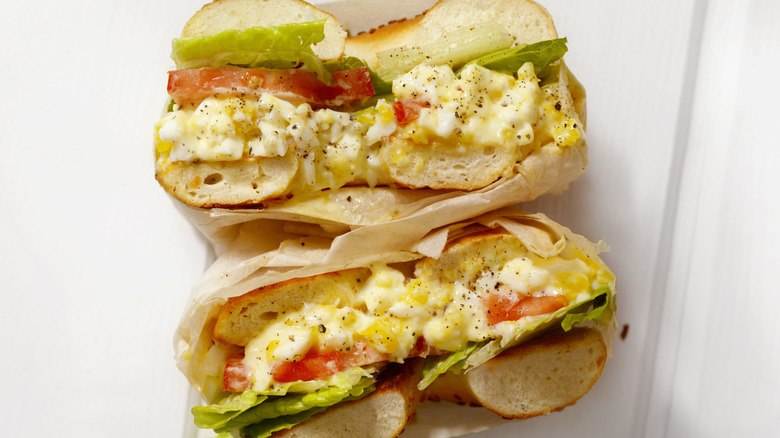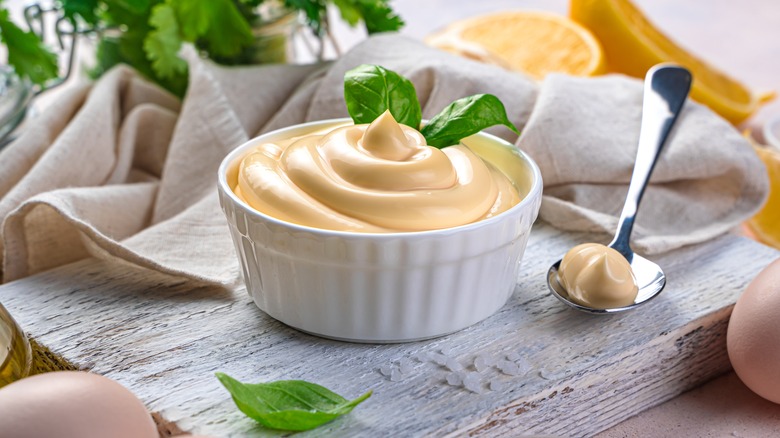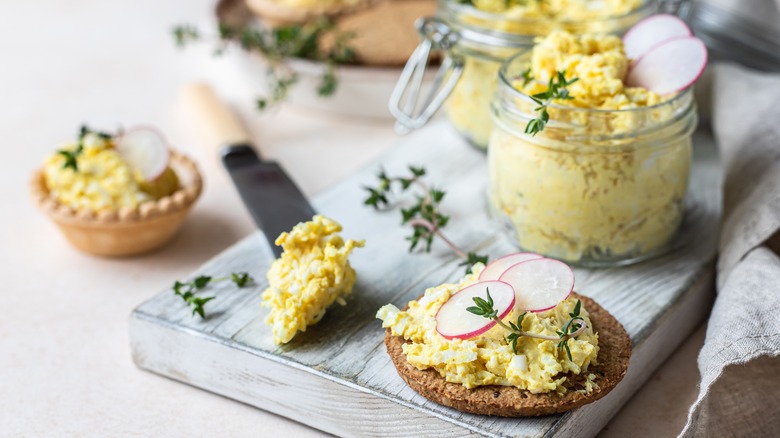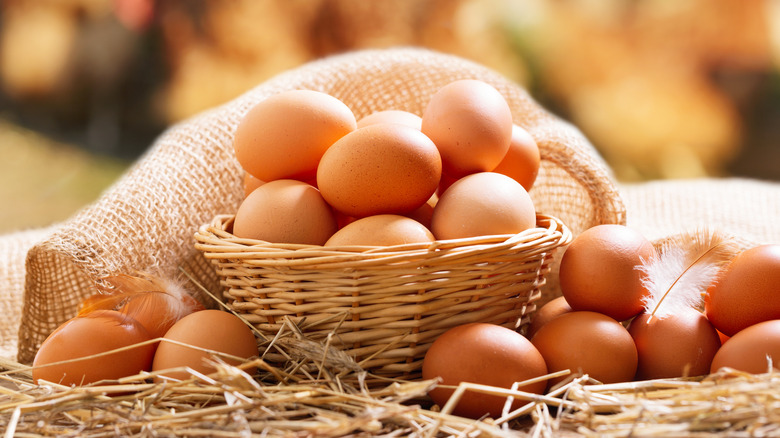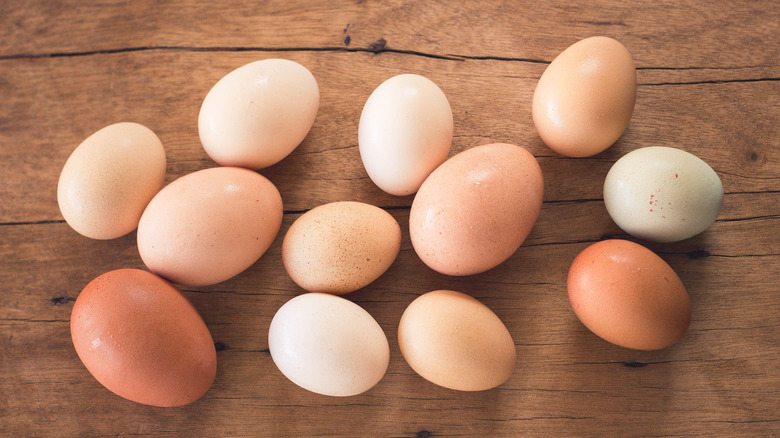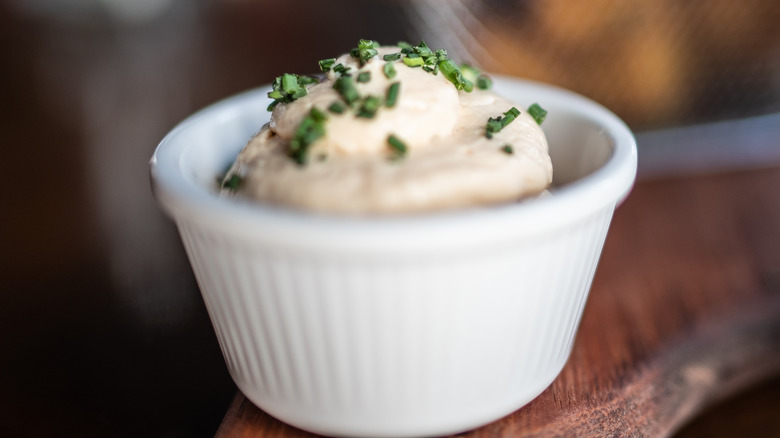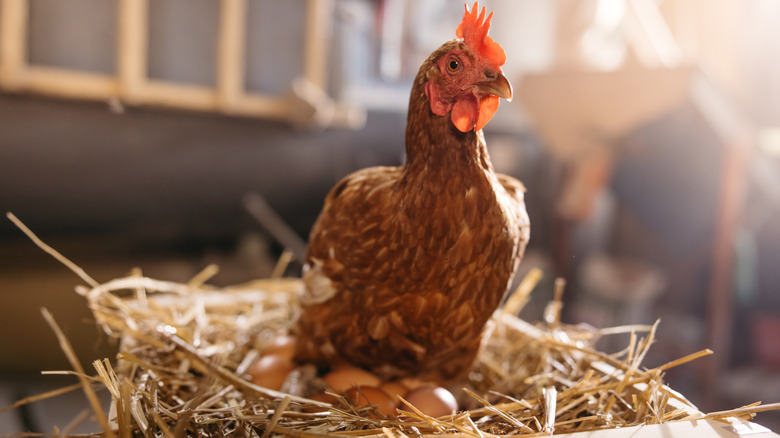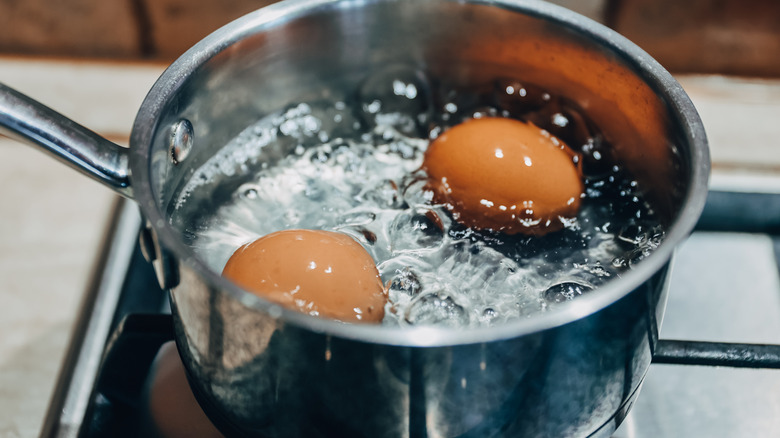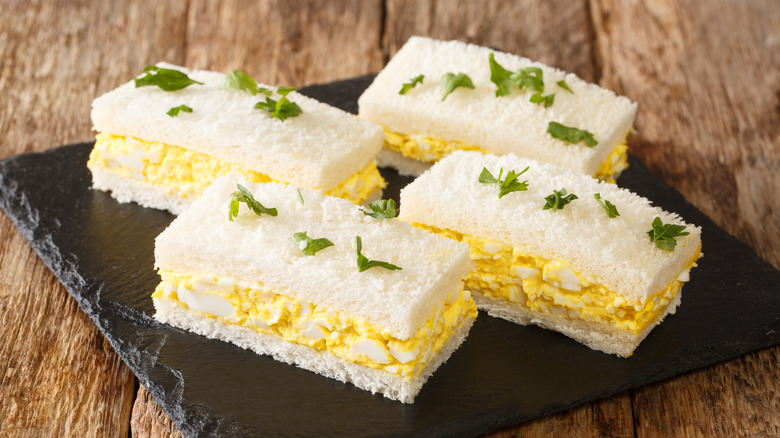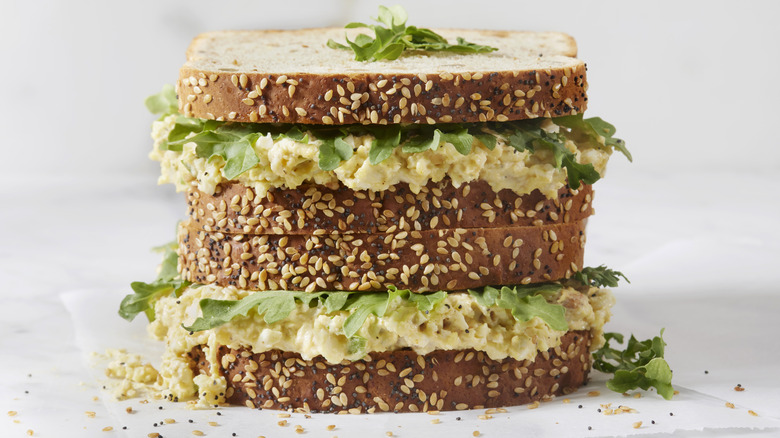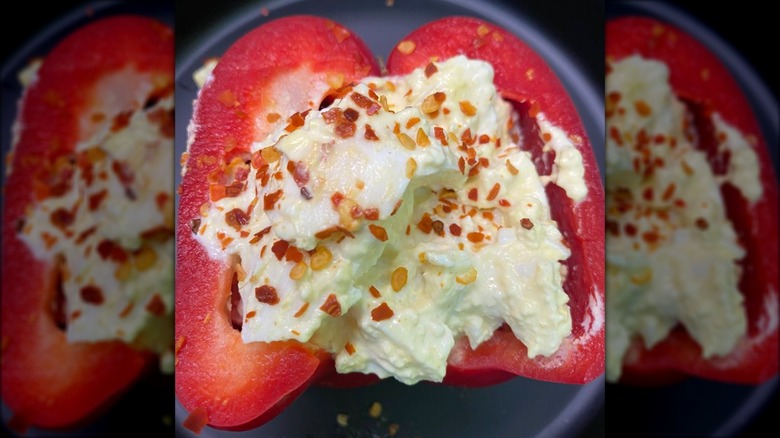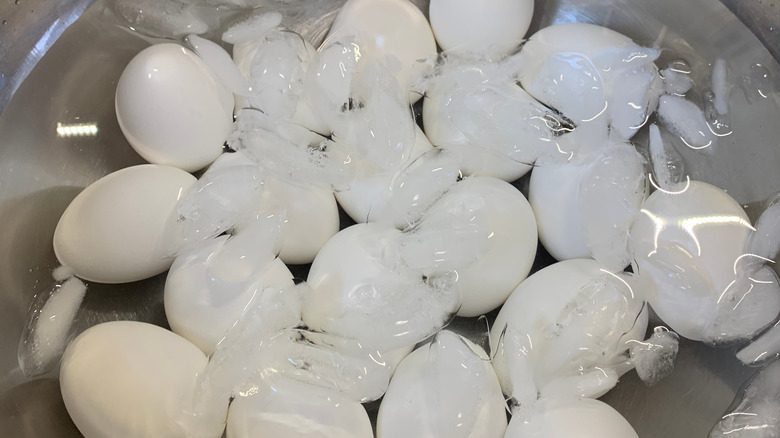False Facts About Egg Salad Everyone Believes
Before you whip up your next batch of egg salad, we want to clear up any misconceptions you have about this creamy, comforting salad. If you believe the myths, you've likely been worried about food safety concerns that aren't an issue, operating under nutritional misconceptions, and making inferior egg salad all your life. Luckily for you, we're ready to swing in with some egg-cellent information to help you navigate the world of egg salad more confidently in the future.
We've uncovered some secrets about eggs and mayo, along with some prep and serving tips that can elevate the flavor and texture of your egg salad, and improve your whole salad experience. Once we've debunked all these egg salad myths, you'll be well on your way to egg salad nirvana, whether you're a seasoned chef or a kitchen novice. Get ready to improve your egg salad game with your newfound knowledge.
Egg salad is healthy
While mayo makes egg salad super creamy and yummy, it has some negatives. So, you should think twice before eating egg salad if you're diet-conscious. Of course, you have to consider the eggs, but the mayo is often the unhealthiest ingredient. Scientists are villainizing eggs less these days. After all, eggs contain plenty of healthy nutrients. In fact, Harvard T.H. Chan School of Public Health says, "While it's true that just one large egg yolk has 200 mg of cholesterol — making it one of the richest sources of dietary cholesterol — eggs also contain additional nutrients that may help lower the risk for heart disease. In addition, the moderate amount of fat in an egg, about 5 grams, is mostly monounsaturated and polyunsaturated fat." Experts still only recommend one egg a day for healthy people. However, a typical egg salad recipe contains closer to three eggs per serving.
Mayonnaise contains even more eggs and oil. If you're not making your mayonnaise for your salad from scratch, you're likely buying mayonnaise with highly processed oil (like soybean oil) as one of the main ingredients. With an ordinary serving of the salad containing around 2 tablespoons of mayo, the mayo alone adds around 200 calories and 24 grams of fat (30% of the daily value).
There's no way to make egg salad more nutritious
There are several ways to make egg salad more nutritious. When trying to make healthier egg salad, you'll want to pay attention to the types of eggs you use, what you use to make it creamy, and your add-in choices. When it comes to eggs, you can get more nutrients from omega-3-enriched eggs than regular eggs. Choosing mayo made with olive oil or avocado oil can provide more "good fats" than the ones made with soybean oil. Or you can skip mayo altogether and use a mayo alternative (more about that later).
Add-ins like fresh herbs and vegetables can also add nutrition. We suggest veggies like green onions, peppers, celery, and olives. Even a sprinkling of dried seaweed can increase the nutritional value. You can also give it a nutritional boost by serving it on a bed of raw greens like lettuce or spinach.
You can only make egg salad with mayo
Mayo isn't the only way to hold this salad together. One way to change the nutritional value or flavor of egg salad is to make it with a creamy or fatty ingredient that isn't mayonnaise. The most obvious substitutions are plain yogurt or sour cream. They're both creamy like mayo, but they also provide an extra tartness that can add some interest to your salad. It's a 1-to-1 swap for mayo in your recipe. If you use a couple of tablespoons of full-fat yogurt per serving, you'll only end up adding 26 calories and about a gram of fat to the eggs. With sour cream, you'll be adding 60 calories and 5 grams of fat, but it's still less than adding mayo. Other dairy options include crème fraîche, ricotta, cottage cheese, and cream cheese.
Avocado isn't just for guacamole and toast; it also works nicely as a mayo substitute. The ratio of avocado to boiled eggs is 1-to-6, so plan accordingly. If you find that you've added avocado before it's mushy, you might want to try adding a bit of olive oil or lemon juice for moisture. The lemon juice will help prevent the avocado from turning brown, so you might want to add it anyway. Just be aware that adding a whole avocado to your salad will add more calories and fat, but at least most of it is monounsaturated and polyunsaturated fat (the good kinds).
Your way to make egg salad is the best
If you've only been making egg salad one way all your life, it's time to branch out and explore the possibilities. While your tried-and-true recipe is comforting and familiar, there are so many ways you can improve even the best egg salad. There's no reason it has to taste like deviled eggs either. The list includes substitutions, add-in ingredients, and spices.
Of course, you can change up your salad by adding a different kind of dairy and non-dairy creamy ingredients besides mayo. Your favorite prepared mustard, horseradish, or pesto can also give it a kick. Consider adding extra protein with bacon crumbles, shredded cheese, nuts, seeds, or ham. Vegetables like carrots, green peas, cucumbers, pickles, jalapenos, your favorite type of olive, and sundried tomatoes can add extra flavor and sometimes crunch. Alliums like onions and garlic provide extra flavor, as do herbs and spices. Try ranch dressing powder, fresh dill, parsley, chives, curry, or paprika. You can even go sweet by adding fruits like apples, pineapple, papaya, or mango. Other ideas include adding caviar, capers, or pickle juice. Some people even start their egg salad with fried eggs instead of boiled eggs.
Egg salad made with brown eggs is healthier
We're not sure where people got the idea that brown eggs are healthier than white eggs, but it simply isn't true. The difference between white and brown eggs is not the same as the difference between white and brown bread. After all, there's no such thing as "whole grain eggs." The USDA has confirmed that "the color of the shell doesn't affect nutrient content."
So, what makes some eggs brown or other colors besides the white ones that are most prevalent at grocery stores? The difference lies in which type of chicken is laying the egg. Cartons of brown eggs come from chickens like Rhode Island chickens (both Reds and Single Comb Whites), New Hampshire chickens, and Plymouth Rock chickens (both Barred and White varieties). Buff Orpingtons and Black Australorps are also among the chickens that lay brown eggs. So, you can get whatever color egg you want without affecting the nutritional quality or even the flavor of your salad. They just come from different types of chickens.
It doesn't matter what size egg you use for your recipe
There are two reasons that size matters for your egg salad: taste and ingredient proportion. Depending on which egg size you use, you'll need fewer or more eggs for the recipe. Smaller eggs taste better, but you'll mainly find larger ones at the grocery store. Home-grown eggs are often smaller and better tasting. The size of the eggs relates to breed, diet, living conditions, and how long the chickens have been laying eggs. They start from 15-ounce per dozen peewee eggs that young chickens lay and range all the way to jumbo eggs, which are twice the size at 30 ounces per dozen. Neither of the two extremes is readily available at the grocery store. The smallest size you'll usually find at your local supermarket are medium eggs, which are 21 ounces per dozen. Older chickens lay more eggs and larger eggs, which is why you see larger eggs in the store.
When you're looking at a recipe for two servings that calls for six eggs, it means six large eggs since these are the standard size. However, if you have anything but large eggs, you'll need to adjust the recipe. If the recipe calls for six large eggs, you'll need eight small, seven medium, or five extra large or jumbo eggs.
Mayonnaise makes egg salad more likely to cause foodborne illnesses
Because mayonnaise contains raw eggs, it makes some people nervous that egg salad may spoil faster than some other foods. However, this simply isn't true. A study in the Journal of Food Protection found something amazing, "Salmonella, E. coli O157:H7, E. coli, L. monocytogenes, Staphylococcus aureus, and Yersinia enterocolitica die when inoculated into mayonnaise and dressings." Yes, you read that correctly. The acid level in mayonnaise is actually high enough to turn it into a bacteria killer.
So, instead of making it more prone to bacterial contamination, egg salad made with mayonnaise is actually safer from these pathogens. That's one reason mayonnaise lasts so long in the fridge without going bad. Of course, there is a limit to the percentage of pathogens it kills and how long mayo can keep your food safe. However, another Journal of Food Protection study found that the more mayo in a salad, the slower pathogens grew when left out for a while. So, bring on the mayo!
Fresh eggs are best for egg salad
When it comes to many recipe ingredients, fresher ingredients are better. However, when it comes to eggs, fresher eggs are more difficult to peel, which makes the process of making egg salad more challenging. When cooking older, room-temperature eggs in boiling water, you'll find them far easier to peel than fresh eggs. Nobody likes ending up with raggedy eggs with shells sticking to them. There's also nothing worse than crunching down on tiny pieces of eggshell in your salad.
As eggs age, they become less acidic and more alkaline, which helps them separate better from their shells during the boiling process. By the time your eggs have been in the fridge for a few weeks, they become much easier to peel. However, if you didn't plan ahead and only have fresh eggs, you're not doomed to have difficult-to-peel eggs. You can still raise the alkalinity of the egg by adding a half teaspoon of baking soda for every quart of boiling water. Unfortunately, you'll end up with a more sulfurous-tasting egg salad, which is why fresh eggs are still best.
It doesn't matter how long you boil the eggs
When you boil eggs for egg salad, you want egg yolks that are moist rather than dry or runny. The U.S. Department of Health and Human Services says that you're less likely to get a foodborne illness from eggs if you ensure that both the egg whites and yolks are firmly cooked. If you only boil the eggs for 5 or 6 minutes, the inner yolk will still be runny. Once you hit the 10-minute mark, you'll start to have eggs with yolks that are still moist and pasty. However, if you let them boil for a full 15 minutes, you'll end up with an overly dry yolk. The longer you cook older eggs (which we've established as the best to use), the more likely they are to turn gray or green. This happens from the sulfur and iron in the egg combining to form ferrous sulfide. So, to avoid dry egg salad with a grayish, greenish tint, you'll want to keep a watch on how long you let the eggs boil.
When Mashed asked chef Devan Cameron how to make the perfect hard-boiled egg, he said, "Large eggs need 12 minutes of cooking in boiling water if they're cold from the fridge, and 11 minutes if they're at room temperature. Small eggs will only need 10 minutes of boiling to be effectively hard-boiled." So, size matters.
You should chop the egg whites and yolks together
If you've been chopping the egg whites and yolks together, you've been making your egg salad wrong. Imagine this: smooth, deviled-egg-filling egg yolks mixed with chunks of egg whites. Now we're talking! This way, you're basically making deviled egg salad. Texture matters. Smooth-yolked egg salad is the type you'll find in egg salad sandwiches (tamago sando) in Japanese convenience stores like 7-Eleven. The smooth yolks and chopped whites make for a better egg salad experience. Anthony Bourdain even tweeted about them when he visited Japan in 2013, describing them as having "inexplicable deliciousness."
To make the yolks super fluffy, you can either squish them with your hands (definitely the most fun and satisfying method), blitz the yolks in a food processor, or press the yolks through a sieve. The sieve method gives you far smoother yolks when you combine them with the mayo, chopped egg whites, and the rest of the ingredients.
The type of mayo you use doesn't matter
The type of mayo you use matters if you want to create the best egg salad possible. We suggest tangy and creamy mayos that aren't overly sweet. People sometimes have some really strong feelings about their favorite mayo, and our really strong feeling is that you shouldn't be using Miracle Whip in egg salad. In fact, it's not even technically mayo according to the FDA, since mayo must contain 65% vegetable oil or more. Thus, it's labeled "dressing" rather than "mayonnaise" on the label. While Miracle Whip is lower in calories and fat than mayo, it's not necessarily healthier since it contains high fructose corn syrup. High-fructose corn syrup also makes it taste sweet, which may not be what you want from your salad. And if you don't cool your eggs first, you can end up with a greasy, separated mess of a salad.
Mayo varieties we do suggest are real ones. Japanese Kewpie mayo (the mayo used in Japan's popular 7-Eleven sandwiches) is a good choice because of its thickness, tanginess, and its complex flavor. Its distinctive flavor comes from MSG, its vinegar blend, and a higher proportion of egg yolks. If you don't have access to Kewpie, we recommend another thick and tangy mayo like Duke's, which has a rabid fan following.
You should eat egg salad on white bread
Egg salad goes on white sandwich bread, right? Sure, that's how we tend to envision it, thinking back to how we've seen it in our childhood kitchens and picnics. However, ordinary white bread isn't the best choice. The famous, fluffy Japanese egg salad sandwiches come on pieces of flavorful, light-as-air Japanese milk bread (shokupan). While it's still a type of white bread, it's a superior tasting to American brands like Wonder Bread. If you can't find any milk bread and want something close, you can try brioche, although brioche is a little sweeter.
While milk bread is tasty, the most nutritious bread choice for the salad is whole-grain bread. Kristin Kirkpatrick, M.S., R.D., L.D., told Healthline that the white flour milling process "removes layers of essential nutrition: B vitamins, minerals, proteins, healthy fats, and fiber in the bran and germ layers removed. This leaves the white flour with only the endosperm, containing all the starch without a lot of nutrient density." So, choose milk bread for flavor or whole-grain bread for nutrition.
The only way to eat egg salad is in a sandwich
If you've never tried eating egg salad any way except in a sandwich, you're missing out. What other ways can you eat egg salad that's not a sandwich? Most options include using it as a stuffing or topping for vegetables.
There are several options for eating it that's not a sandwich. One idea you may not have considered is to use it as a filling for a breakfast quesadilla, along with cheese. There are also several ways to use it as a stuffing. You can place the salad inside cut pieces of celery to make a different type of ant-on-a-log creation with olives, seeds, or nuts standing in for ants instead of raisins. Another option is to hollow out part of an avocado and use it as an avocado stuffing. Other vegetables work for stuffing the salad into, like peppers or hollowed-out tomatoes. Another option is to serve it on top of greens. While you're at it, you could mix it into your vegetable salad, kind of like a deconstructed deviled egg salad. Now that you have a few ideas, it might fuel your imagination for other ways to use it.
It's fine to use hot eggs in egg salad
We know that you're excited to eat egg salad as quickly as possible after you make it, but we beg you not to make the dish with hot eggs. It's especially a good idea to start with chilled eggs if you plan to save some for later. Chilled eggs improve the salad's consistency, flavor, and color.
Chilling your eggs before making your salad helps to prevent any leftover egg salad from becoming watery. And if you insist on using Miracle Whip instead of real mayo (some habits are hard to break), you could find that the dressing splits and starts to look greasy and gross if you mix it in with hot eggs. Luckily, it doesn't take a lot of effort or time to chill the eggs. Simply place them in ice water. The ice water both completes and stops the egg's cooking process. Stopping the cooking process is important because overcooked eggs can end up with gray-green yolks. It's easier on your hands to peel cool eggs rather than hot eggs anyway, so it's a win-win situation all around.
